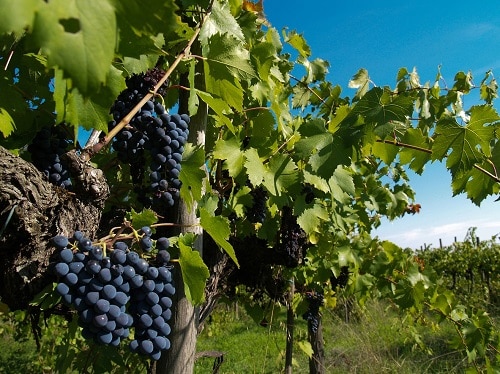Norton Grape Variety & Wine Profile
Known as the oldest American wine grape, Norton has created quite a name for itself across states in the Midwest and Mid Atlantic in the United States. Originally cultivated by Dr. Daniel Norborne Norton in Richmond, VA in the early 19th century as a cross between Vitis vinifera and the American Vitis aestivalis vine, Norton became commercially available in 1830 and soon dominated the midwestern wine production during that time. In 1873 at the Vienna World Exposition wine competition, a Norton wine from Missouri won a gold medal and the title “best red wine of all nations,” catapulting the American Norton grape onto the world stage. However, when prohibition hit the States, many Norton vineyards were replaced with concord grape plantings and production of the wine stopped. It was not until 1989 when Dennis Horton founded Horton Vineyards in Virginia and planted more Norton vineyards that the wine became a mainstay in the modern wine industry.
RELATED: 10 Wineries To Visit in Virginia Near Washington DC
Terroir & Production
Norton grapes are very hardy and grow well in cool or moderate climates in sandy or gravelly loam soils. Though strong in the vineyard and tolerant of cooler temperatures, the grapes require a longer growing season, which is why they are not found in the colder regions of the northeast. The grapes have higher levels of anthocyanins than other grape cultivars, which contribute to a darker pigmentation on the skins. Because they are native, Norton vines tend to be more resistant to vineyard pests and diseases in North America.
Many producers utilize malolactic fermentation in the winery to soften the harsh malic acids in this wine, and some have even turned to carbonic maceration in Norton wine production. Blending with other black grapes such as Cabernet Sauvignon to add and accentuate flavors and structure is common. Though known as the official state grape in Missouri, the largest Norton plantings in the world are located at Chrysalis Vineyards in Middleburg, VA.
The Tasting Notes of Norton Wines
In the glass, Norton is recognized by its signature deep purple color, medium to full body, and medium to high acidity levels. The tannin structure ranges from silky smooth to rough. The flavors of the wines made with Norton include black currant, black cherry, plums, chocolate, dill, and some pepper. It has done better as a commercially viable wine than other native American vines such as Vitis labrusca because it lacks the “foxy” characteristics that many native American grapes display when made into wines. Norton wines have a higher level of resveratrol, which is a compound that is said to be good for heart health.
Food Pairing Suggestions
When pairing Norton wines with food, it’s important to think in terms of heavier, gamier meats. Venison and smoked meats are also a perfect match. The wine can be inky dark and have pronounced dark flavors that can rival pairings for Cabernet Sauvignon.
Learn About These Other Wine Grape Varieties
Written By Jacqueline Coleman
Jacqueline Coleman is a professional wine + travel writer, wine judge, columnist, and consultant based in Miami, FL.
